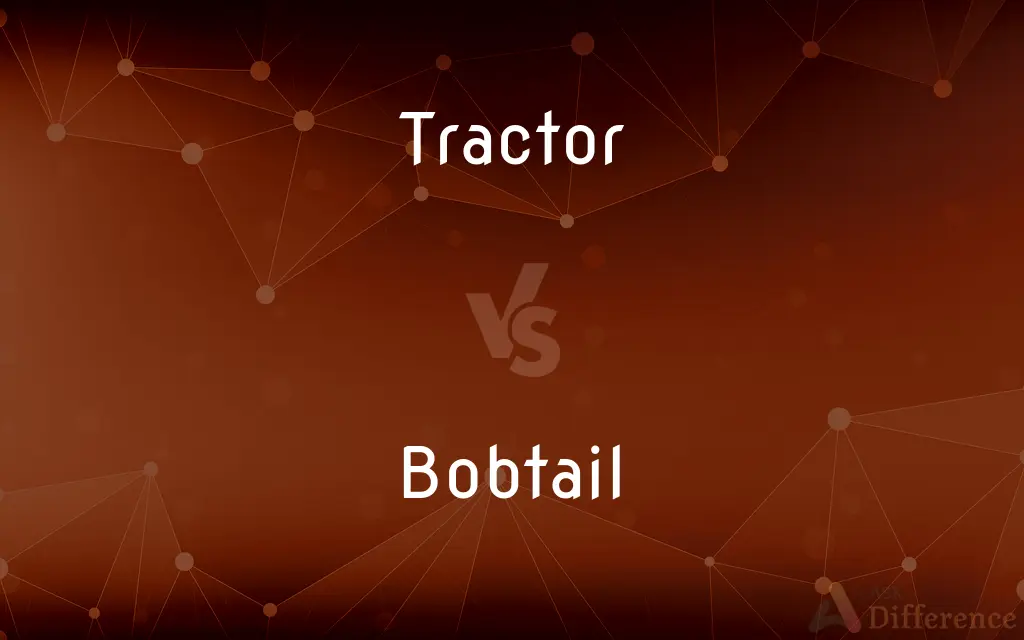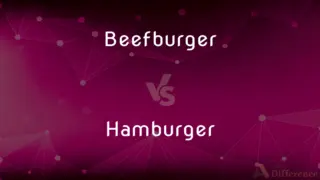Tractor vs. Bobtail — What's the Difference?
By Urooj Arif & Maham Liaqat — Updated on April 23, 2024
A tractor is designed for heavy agricultural work, while a bobtail refers to a semi-truck without its trailer, often used in short-hauls.

Difference Between Tractor and Bobtail
Table of Contents
ADVERTISEMENT
Key Differences
A tractor is primarily used in farming and agricultural settings for tasks such as plowing, tilling, and planting. On the other hand, a bobtail is a term used in the trucking industry to describe a semi-truck operating without its trailer, typically seen in logistics and short-haul transportation.
Tractors are equipped with powerful engines and large wheels designed to navigate rough, uneven farmland. They are built for pulling heavy farm equipment. Conversely, bobtails, while also having powerful engines, are designed for road use, emphasizing maneuverability and the ability to operate in a variety of logistic roles without the encumbrance of a trailer.
In terms of functionality, tractors are versatile machines with attachments for a wide range of agricultural tasks, from harvesting to fertilizing. Bobtails, however, are more specialized; their primary function is to transport goods over short distances or move semi-trailers within a freight yard or docking area.
The design of tractors focuses on durability and the ability to perform in diverse agricultural environments, featuring protective elements for the machinery and the operator. Bobtails, in contrast, prioritize the comfort and safety of the driver for long hours on the road, with features such as advanced navigation systems and ergonomic seating.
The economic roles of tractors and bobtails differ significantly. Tractors are pivotal in the production phase of agriculture, directly contributing to the cultivation and harvesting of crops. Bobtails, however, play a crucial role in the distribution phase, facilitating the movement of goods from producers to markets or retail locations.
ADVERTISEMENT
Comparison Chart
Primary Use
Agricultural tasks
Short-haul trucking without trailer
Environment
Farmland
Roads, freight yards
Attachments
Plows, seeders, harvesters
N/A
Design Focus
Durability, versatility
Maneuverability, driver comfort
Economic Role
Production
Distribution
Compare with Definitions
Tractor
Essential for modern farming efficiency.
With the tractor, they doubled their field’s output.
Bobtail
A semi-truck operating without a trailer.
The driver took the bobtail to pick up a new load.
Tractor
A powerful vehicle used for agricultural tasks.
The farmer used a tractor to plow the fields before planting.
Bobtail
Used for short-haul trips or moving trailers.
They used a bobtail for the quick delivery across town.
Tractor
Equipped with large wheels for rough terrain.
Their new tractor has improved tread on the tires for better traction.
Bobtail
Important for logistics and freight management.
Bobtails streamline operations within shipping yards.
Tractor
Can be fitted with various farming implements.
He attached a seeder to the tractor for efficient planting.
Bobtail
Lacks the cargo capacity of a full semi-truck.
Bobtails navigate urban areas more easily than full trailers.
Tractor
Symbolizes agricultural innovation.
The introduction of tractors revolutionized farming practices.
Bobtail
Often seen in trucking and transport industries.
Bobtailing is a common sight in logistic hubs.
Tractor
A tractor is an engineering vehicle specifically designed to deliver a high tractive effort (or torque) at slow speeds, for the purposes of hauling a trailer or machinery such as that used in agriculture, mining or construction. Most commonly, the term is used to describe a farm vehicle that provides the power and traction to mechanize agricultural tasks, especially (and originally) tillage, but nowadays a great variety of tasks.
Bobtail
A docked tail of a horse or dog.
Tractor
A powerful motor vehicle with large rear wheels, used chiefly on farms for hauling equipment and trailers.
Bobtail
A short or shortened tail.
Tractor
A vehicle having a powerful gasoline or diesel motor and usually large, heavily treaded rear tires, used especially for pulling farm implements or machinery.
Bobtail
An animal, such as a horse, having a short or shortened tail.
Tractor
A truck having a cab and no body, used for pulling large vehicles such as vans or trailers.
Bobtail
Something that has been cut short or abbreviated.
Tractor
An airplane propeller mounted in front of the supporting surfaces.
Bobtail
A short, or deliberately shortened tail.
Tractor
An airplane having such a propeller.
Bobtail
An animal that has a bobtail, such as certain canines or nags.
Tractor
A toothed mechanism that automatically advances perforated continuous-form paper through a computer printer.
Bobtail
(agriculture) A tractor which performs without its trailer.
Tractor
(agriculture) A vehicle used in farms e.g. for pulling farm equipment and preparing the fields.
Bobtail
A tractor-trailer that is relatively short in length.
Tractor
(agriculture) A movable coop without a floor to allow for free ranging.
Bobtail
The tractor unit of a semi-truck without a trailer
Tractor
(US) A truck (or lorry) for pulling a semi-trailer or trailer.
Bobtail
An open-ended straight or four flush.
A bobtail flush
Tractor
Any piece of machinery that pulls something.
Bobtail
(agriculture) To drive a tractor without its trailer.
Tractor
(aviation) An aeroplane where the propeller is located in front of the fuselage.
Bobtail
To drive a truck or other vehicle without its trailer.
Tractor
A British Rail Class 37 locomotive.
Bobtail
An animal (as a horse or dog) with a short tail.
Tractor
(archaic) A metal rod used in tractoration, or Perkinism.
Bobtail
Bobtailed.
Tractor
To prepare (land) with a tractor.
Bobtail
A short or shortened tail of certain animals
Tractor
To move with a tractor beam.
Bobtail
Large sheepdog with a profuse shaggy blue-gray-and-white coat and short tail; believed to trace back to Roman occupation of Britain
Tractor
To treat by means of tractoration, or Perkinism.
Bobtail
Having a short or shortened tail;
Bobtail mare
Tractor
That which draws, or is used for drawing.
Tractor
Two small, pointed rods of metal, formerly used in the treatment called Perkinism.
Tractor
A motor vehicle with a powerful engine and large wheels, used to pull farm equipment such as plows, harvesting machinery, etc., over farm land. Smaller forms of farm tractor are completely open, with only a seat for the driver.
Tractor
A motor vehicle with a driver's cab and a powerful engine, fitted with a coupling at the rear, and designed to pull a large trailer or semi-trailer on the open highway; - called also truck tractor. The combination of such a tractor with its trailer is called a tractor-trailer, and is a common form of truck used for commercial shipping of freight.
Tractor
A propeller screw placed in front of the supporting planes of an aëroplane instead of behind them, so that it exerts a pull instead of a push; - called also Tractor screw and Tractor propeller.
Tractor
An airplane having one or more tractor propellers; - called also tractor airplane.
Tractor
A wheeled vehicle with large wheels; used in farming and other applications
Tractor
A truck that has a cab but no body; used for pulling large trailers or vans
Common Curiosities
Is a bobtail useful in agriculture?
Bobtails are not typically used in agriculture due to their design for road and logistical use, not for farming tasks.
What is the main difference between a tractor and a bobtail?
The main difference is their primary use; tractors are used for agricultural work, while bobtails are semi-trucks without trailers, used in logistics.
Can a tractor be used for transportation like a bobtail?
While tractors can tow agricultural equipment, they are not designed for the same type of transport tasks as a bobtail.
How do bobtails contribute to the distribution process?
Bobtails facilitate the efficient movement and organization of trailers and goods in logistics, aiding in the distribution process from producer to market.
Can you drive a bobtail without a special license?
Operating a bobtail generally requires a commercial driver's license (CDL), similar to driving a full semi-truck.
Do tractors have features for driver comfort?
Modern tractors often include features for operator comfort, such as air conditioning and ergonomic seating, though not as extensively as vehicles designed for road use.
How does the design of a tractor benefit agricultural work?
A tractor’s design, including its large wheels and powerful engine, is optimized for pulling heavy farm equipment and navigating uneven terrain.
What makes a bobtail maneuverable?
Without a trailer, bobtails are shorter and lighter, allowing for easier turning and handling, making them more maneuverable in tight spaces.
Why might a truck driver use a bobtail?
Truck drivers use bobtails for tasks such as moving trailers within a freight yard or for short-haul deliveries without the need for a full trailer.
Are tractors limited to farming?
While primarily designed for agriculture, tractors can also be used in construction and industrial settings for tasks requiring heavy lifting and towing.
Share Your Discovery

Previous Comparison
Parlay vs. Parley
Next Comparison
Beefburger vs. HamburgerAuthor Spotlight
Written by
Urooj ArifUrooj is a skilled content writer at Ask Difference, known for her exceptional ability to simplify complex topics into engaging and informative content. With a passion for research and a flair for clear, concise writing, she consistently delivers articles that resonate with our diverse audience.
Co-written by
Maham Liaqat













































